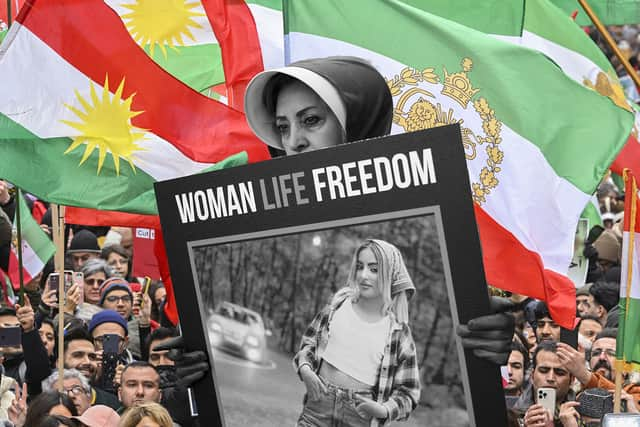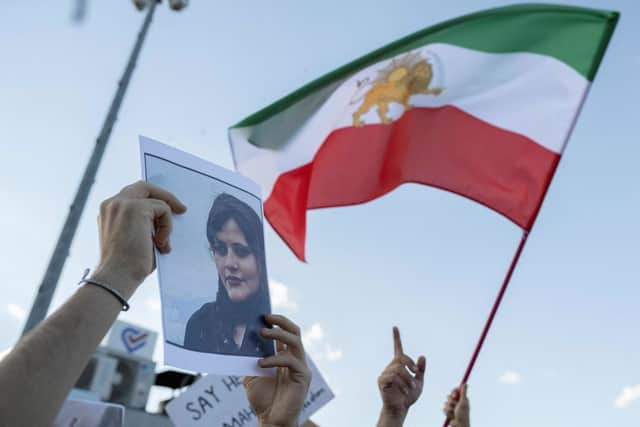Iran protests explained six months after death of Mahsa Amini - is this a turning point for the regime?
and live on Freeview channel 276
“The flame has been lit and it is not going to die anytime soon.”
Those are the words of Iranian woman, exile, and activist Azadeh Zabeti, speaking to NationalWorld six months after a wave of anti-regime protests erupted across Iran. They were first sparked by the tragic death of 22-year-old Mahsa Amini, who died after being detained for allegedly wearing her hijab too loosely. Police claimed she passed away from a heart attack, but her family cast doubt on this and alleged she had been killed.
Advertisement
Hide AdAdvertisement
Hide AdIranians subsequently took to the streets in an outcry against the government’s treatment of women - but they have been met by Iran’s brutal ‘morality police’, who have violently cracked down on protesters. The latest estimates state that more than 750 Iranians, including children, have been killed during the protests, while more than 30,000 have been imprisoned. They will “no doubt be facing cruel, inhumane, and degrading punishment”, Ms Zabeti, who fled Iran with her parents in 1980, added.
Iran has also carried out four state executions over the past few months. Those known to have died are Mohsen Shekari, Majidreza Rahnavard, Mohammad Mehdi Karami, and Seyed Mohammad Hosseini, all of whom were publicly hanged. It is believed that dozens of other prisoners are also currently on death row.
But in spite of Iran’s regime doing “everything it can to brutally oppress, persecute, and crack down on the freedom-aspiring Iranians,” Ms Zabeti remarked, “the protests continue unabated.” She said she believes this will continue for as long as is necessary for their aspirations to be realised, as “the flame has been lit and it is not going to die anytime soon.”
“Iran prior to the killing of Mahsa Amini and Iran after the killing of Mahsa Amini are two very different things,” she insisted.


What are the protests about?
Advertisement
Hide AdAdvertisement
Hide Ad“Iranians want a free, democratic, and secular republic,” Ms Zabeti explained. “One where the human rights of all Iranians, particularly women, are respected and enshrined in law.”
Women are currently restricted through harsh dress policies and mandatory veiling rules - and many simply want to be offered the choice on what they wear. The regime also views wearing a headscarf as a religious choice, meaning those who don’t are viewed as anti-Muslim - so protesters want a separation between government and religion.
Crucially, anyone who rejects the rules of the regime is met with oppression and violence. So in addition to campaigning for greater freedom for women, the protests are also about bringing an end to a brutal and repressive regime.
What has happened so far?
Many of the protests have been ‘peaceful’, with women burning their hijabs or cutting their hair. People have also been chanting - on the streets, from their balconies, at events - and Iran’s football team refused to sing its national anthem at Qatar’s FIFA World Cup in November.
Advertisement
Hide AdAdvertisement
Hide AdSometimes the demonstrations have turned violent, with some protesters torching buildings of security forces. But activists say this has only come in response to the regime’s violent crackdown on protests.
Reports suggest that Iran’s ‘morality police’ have beaten and shot protesters from the beginning, claiming they are “rioters” and “criminals”. Many Iranians have been detained, where they are punished and tortured, while others have been subjected to ‘enforced disappearance’.
Four executions have also taken place after protesters were convicted of ‘enmity against God’. These have been slammed as “sham trials” by human rights groups, with activists warning that protesters are being tortured into giving false confessions.
“The people protesting know that when they leave home, it is not a given they will return,” Ms Zabeti said. “And they have to worry for their loved ones too, as one of the regime’s tactics is to instil fear into the families of those who have been imprisoned, killed, or forced to disappear.”
Advertisement
Hide AdAdvertisement
Hide AdAs someone who has had family members imprisoned and tortured by the regime, this is something Ms Zabeti understands on a personal level. She is also all too aware that her activism could cause repercussions for her loved ones in Iran.
What can be done?
Governments across the world have condemned Iran’s treatment of protesters over the past several months, with the UK recently imposing 50 sanctions against the regime in response to its human rights violations. But Ms Zebati argues “more needs to be done”.
Speaking for the UK, Ms Zebati said the Islamic Revolutionary Guard Corps (IRGC) needs to be proscribed as a terrorist organisation. This was voted for unanimously on 12 January, following a motion put forward by MP Bob Blackman in the House of Commons, but is not legally binding - so Ms Zebati is urging the government to follow through on the suggestion.
Proscribing the IRGC would send a strong message to the regime - one of “robust and concrete actions,” she said. “The regime is a bully, and like all bullies, only understands this sort of language.”
Advertisement
Hide AdAdvertisement
Hide AdAs part of her work as with the British Committee for Iranian Freedom, Ms Zabeti has also called for the closure of the Iranian Embassy in London - and for all diplomatic ties to be cut with the regime. She hopes too that the Iranian regime’s “appalling” human rights record will be referred to the UN’s Security Council.


“The Iranian people have never asked for nor do we expect external interference in the internal affairs of our country,” Ms Zebati said. “But what we do desire is a more hardline approach to a tyrannical, misogynistic, and evil regime - one that the world would do well to get rid of.”
Is this a turning point for Iran?
This is of course not the first time Iran has seen protests against its regime. The resistance stretches over decades - and many have drawn comparisons between these protests and the 1979 Islamic Revolution.
But in 1979, when Iranians took to the streets to overthrow the monarchy, the revolt was ultimately hijacked by the new regime which still reigns today. So some of the most asked questions recently have been ‘how will these protests be different?’, or, ‘is this finally a turning point for Iran?’
Advertisement
Hide AdAdvertisement
Hide AdMs Zabeti said she has “no doubt” that the protests will continue until the regime is overthrown. She said: “The situation in Iran is so dire that people are risking their lives. Iranians are simply no longer willing to continue to live under the tyranny and oppression that they currently do.”
She added that while a question remains over how much longer the protests will continue, which she suggested will largely be influenced by the actions of international governments, “what is clear from the last six months of protests is that the will of Iranians is an iron will.” She concluded: “They will not return to a dictatorship in any form. So they are in it until the very end.”
Comment Guidelines
National World encourages reader discussion on our stories. User feedback, insights and back-and-forth exchanges add a rich layer of context to reporting. Please review our Community Guidelines before commenting.
